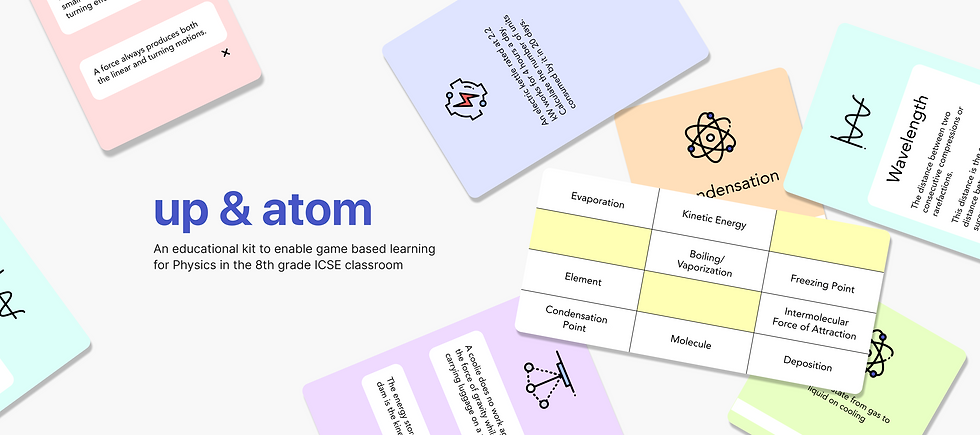
About
As a part of my Remote Design Internship (2020) with Prof. Swati Pal at IIT Bombay, I designed an educational kit to enable game-based learning in the 8th grade ICSE Physics classroom.
The kit consists of 6 games based on the eight chapters of ICSE 8th grade Physics, that can be played in a typical classroom of 30-50 students. These games make use of recurring cards, designed so as to minimize material wastage, and save space.
Role & Skills
Design Intern, User Research, Market Study, Contextual Research, Insight Generation, Prototyping, Visual Design, User Testing and Evaluation
Process
- Understanding
- User Survey
- Market Research
- Current Scenario
- Classroom & Curriculum
- Insights from User Research
Background & Understanding
Growing up, I often felt that learning in the school classroom was not as interesting and absorbing as it could have been. The topics were taught once, followed by an examination or test at the end of the semester, and there were barely any chances given to students to make errors without consequences.
I reached out to some teachers I’ve had the opportunity to learn from before and asked them about their views and opinions regarding an intervention in this area. From our conversations, I inferred that middle schoolers would be a good starting point for 2 main reasons:
Subjects dramatically change from the 5th to the 8th grade (in ICSE board)
Little to no interest in 9th grade+ students for games/activities in the classroom
User Survey
To understand which subjects and topics people had difficulty in understanding in middle school, I conducted user research in the form of an online survey. This survey was targeted at middle school, high school and college students.
I received 110 responses, by people in the age range of 14 to 22 years. I noticed and mapped trends in challenges faced by students in different subjects.
The disconnect between the formulae and the real life applications of Physics seemed like a common issue I identified in the questionnaire results. "It was too theoretical for something that has so many practical applications."
Findings from Market Research
Although several educational games exist for subjects like Mathematics & Biology, there is a shortage of quality Physics educational games. Furthermore, there do not exist quality educational classroom games for ICSE Physics.
Educational games are not used or bought much because they seem to lack the engagement quality present in other recreational games. An educational game/kit for the classroom, built on the school curriculum, would therefore make teachers and students more willing to experiment with it.
Given the insights from the User Survey, Market Research, and my personal scope of knowledge, Physics was chosen as the subject for intervention for this project.
The Current Scenario
School system focuses on a one-size-fits-all learning model, which does not work for many students
Students don’t have a chance to make mistakes w/o consequences before a test
Usage of poor learning techniques
Chapter after being taught once is not revisited in the class itself
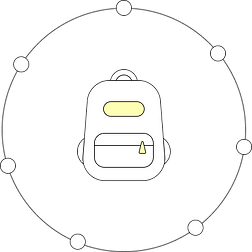
Deductive, teacher centric impartment of knowledge
Low quantity and/or quality of educators
Chance to make connections and draw patterns not given to students
Understanding the Context (the Classroom)
It was imperative to understand the context - the classroom - in which all of this was to take place.
30-50 students in a typical ICSE classroom
Teachers cannot deviate much from the syllabus
Duration of one subject ranges from 30-60 mins
Not enough time to have multiple revisions throughout the academic year
The Curriculum
An understanding of the curriculum involved me pouring over 8th grade Physics textbooks prescribed by ICSE board (once again!) and making notes.
Understanding 8th Graders
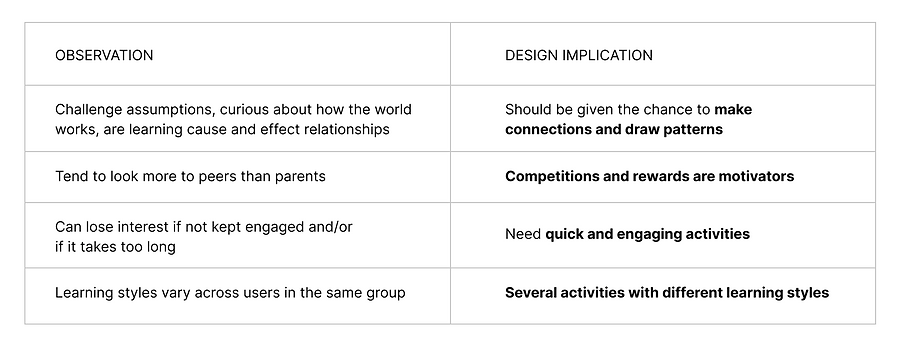
Understanding the Teacher/Instructor

Product Requirements
After gaining a thorough understanding of the current scenario, the context, the curriculum, and insights from the active stakeholders, requirements for the educational kit were defined.
Multiple adequately challenging activities to minimize/avoid repetition and boredom
Making use of efficient learning techniques
Achieving a set of defined learning objectives and outcomes for all chapters in the syllabus
Catering to 30-50 students in a class with different learning styles
Since typical school periods last for 30 mins, games should be quick
Familiar and simple gameplays so students can focus more on the concepts and topics
Continuous Remote Testing
A reiterative, try-and-test approach was adopted for this project, with generated insights used to correct and optimize the design. Weekly sessions were conducted for the same.

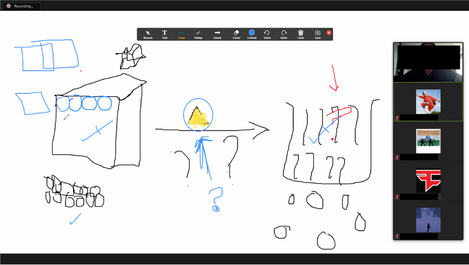
A couple of snaps of the user testing sessions (conducted online due to the COVID-19 pandemic)

Overview
A kit designed keeping in mind the learning objectives of the syllabus, the learning styles, behaviours and needs of 8th grade students, efficient learning techniques, and the classroom context. The teacher acts as the moderator as they conduct the game in the classroom, without expending any additional mental resources, while also communicating using a familiar language to students.
Visual Language
Bright and friendly pastel colours were chosen keeping in mind the target audience. Chapters have been segregated by colours and icons for easy distinction.
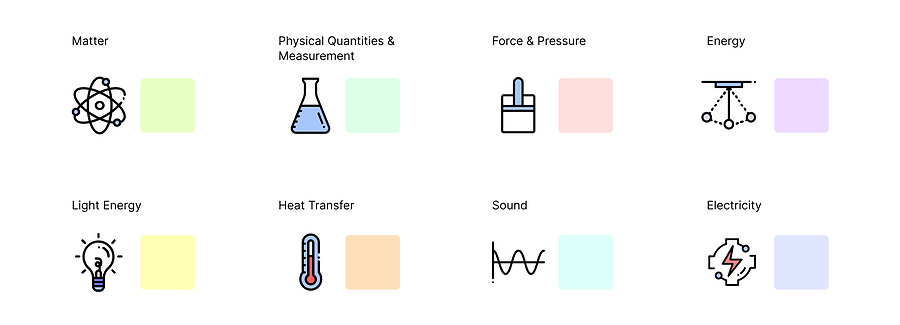
Games have been separated by layout format and/or card size. As some cards can be used for more than one game, it made sense to have a subtle distinction.
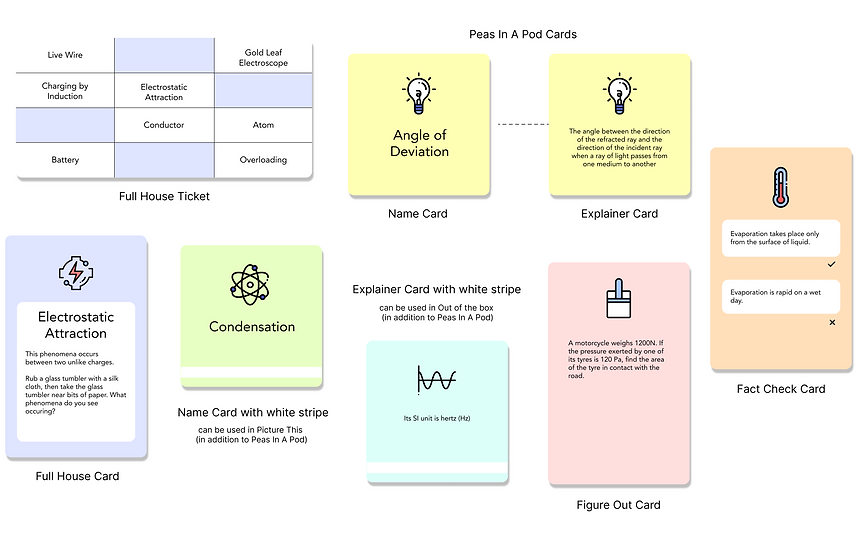
The Games
The kit consists of six games with simple or familiar (adapted from popular games) gameplays.
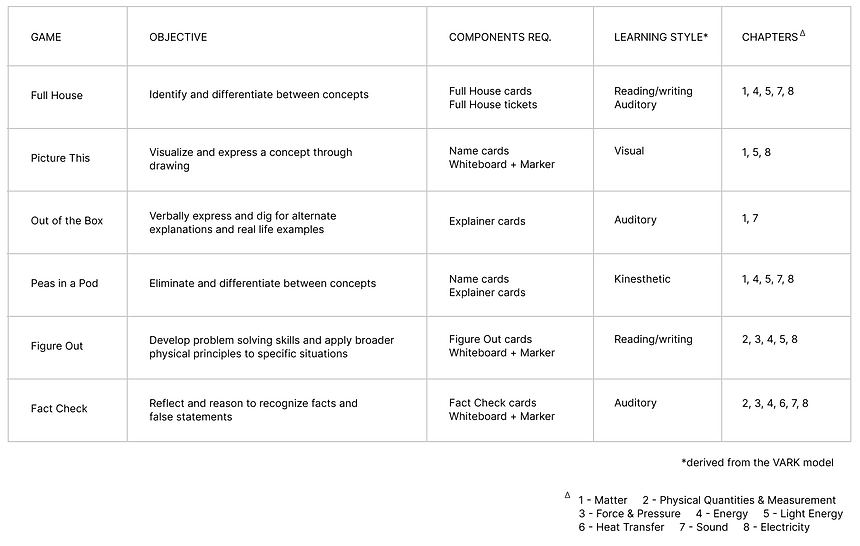
Full House

Full House cards (for teacher’s use - to give hints)

Full House tickets for the students
Each student gets a ticket (no two tickets are the same). Student can strike out concept identified from the hints given (if present on their ticket). First student to strike out all words (correctly) wins the round.
Peas in a Pod
Name cards
Explainer cards
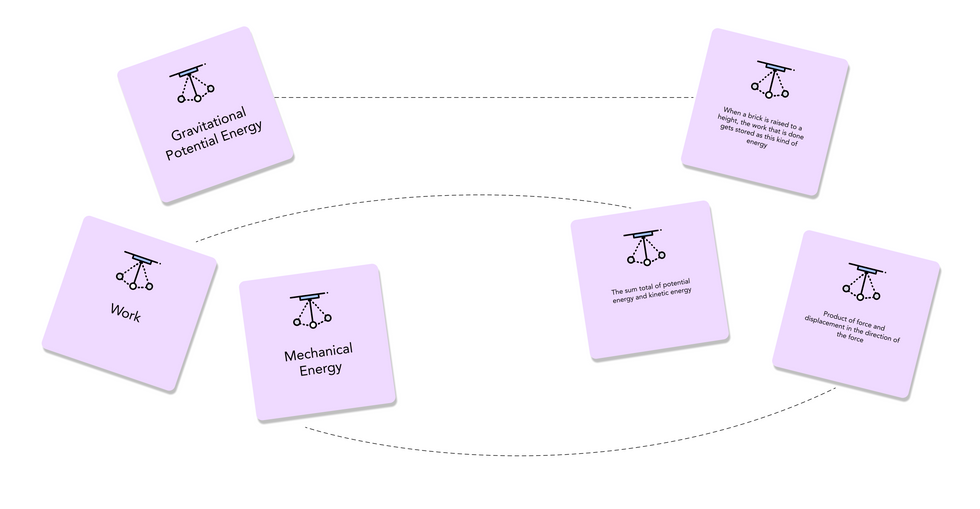
‘Name cards’ and an equal number of matching ‘Explainer cards’ are distributed amongst an even number of students. The student is supposed to find the student with the corresponding Explainer card to his Name card and vice versa.
Picture This
Teams are made according to rows in the classroom. A student from a row picks up a random card which he then has to visually express to his team on the white/black board, while the team members try to identify the concept under a time limit.
(The aim here is not to make a great drawing or accurate diagrams - it is merely to be able to learn to visualize and visually express)
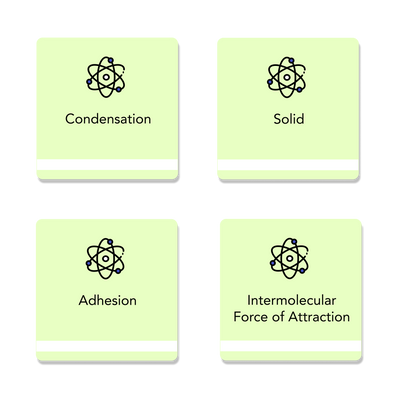
Name cards with white stripe
Out of the Box
Teams are made according to rows in the classroom. A student from a row picks up a random card which he then has to verbally express to his team, WITHOUT using the words already on the card.
Eg: This is “Gas” which can also be described as “state with negligible intermolecular force of attraction and very high intermolecular spaces”

Explainer cards with white stripe
Figure Out
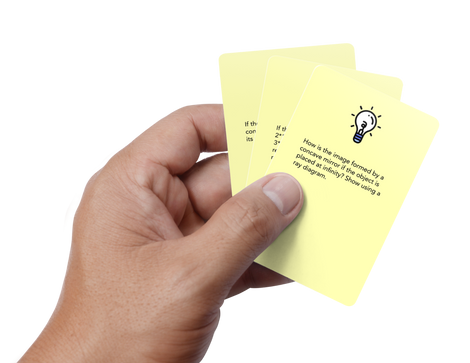
Teams are made according to rows in the classroom. A student from a row picks up a random card which he then has solve to find out the answer.
This is used for numericals as well as diagrams which demand accuracy.
Fact Check
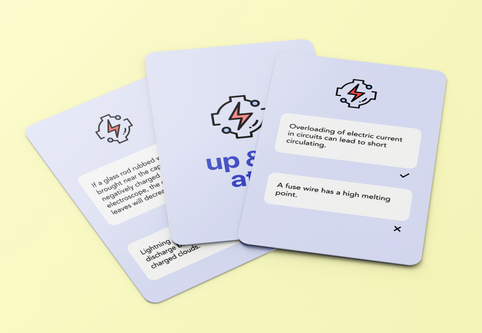
Teams are made according to rows in the classroom. One student from each of the 3/4 rows is nominated for a round wherein the teacher reads out a statement from the Fact Check card. The first student to identify whether the fact is right or wrong wins their row points.
Teacher can ask a follow-up “why” question to further challenge the students.
Multiple games can be mixed and played, and multiple chapters can be revised at the same time by mixing their games.
Learning Techniques Incorporated
Rote learning, highlighting, re-reading, passive revision, have proven to be ineffective learning techniques that are used in most schools till date. The kit makes use of good effective learning techniques such as:
Spaced Repetition
Recalling information before it altogether disappears from the brain by playing all games in the kit in small chunks over time.
Interleaving
Students are forced to switch between ideas and methods while using the games in the kit, and also by mixing the games!
Elaboration
Students are asked to go beyond simple recall of information and start making connections within the content as the play the games.
Concrete Examples
Students are encouraged to come up with real life examples while explaining concepts in games like Picture This and Out of the Box.
Dual Coding
In Picture This, students combine words with visuals to reinforce the concepts in the brain through two different paths, making it easier to retrieve later.
User Evaluation
Full House, Picture This, Out of the Box, Figure Out, and Fact Check were conducted on Zoom. Peas in a Pod could not be tested online due to its kinesthetic nature and need for large participation.
Medium: Google Forms, Zoom
Participants: 7
Form Responses: 6
Preferences in games were highly subjective across the participants. A participant who enjoyed drawing enjoyed Picture This, whereas a participant who preferred verbal expression, enjoyed Out of the Box more. Individual preferences arise due to different learning styles of students. I used the VARK model as a reference for this project.

'How likely are you to play them again with different chapters?'
Success Rate: 93.33%
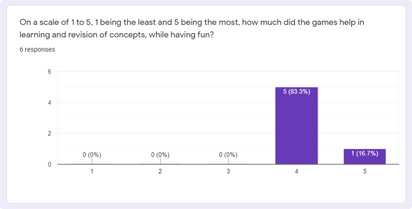
'How much did the games help in learning and revision of concepts while having fun?'
Success Rate: 83.33%
Further Work & Scope
After the pandemic, when schools re-open, I hope to contact a couple of schools and test the product out in the classroom with the actual strength of the class (30-50 students). Zoom can’t replace this!
If proven to be a success and accepted by the school/s, the kit can be manufactured. The project can further be expanded to include other subjects and other grades, as well as built further to create a digital version.
For a soft copy of the entire kit, or to discuss more about the project, you can mail me :)
Reflection & Takeaways
More often than not, characteristics within the target user group will vary and cannot be confined to a few specific characteristics. Understand the extremes is a bit challenging, but important.
Considering and understanding the context is very significant and can make or break the design! Design decisions need to not just be made keeping the users in mind, but also the context.
I also learnt the importance of user testing while iterating - it helps you make quick revisions and versions without spending too much time developing each new version. This approach is particularly helpful in the case of time sensitive projects like this one.
